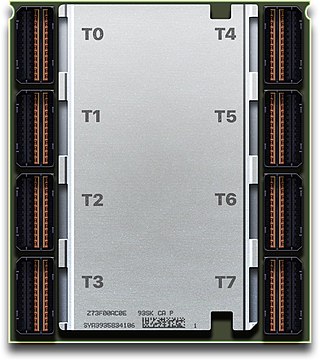IBM PowerHA SystemMirror Timeline

| Developer(s) | IBM |
|---|---|
| Stable release | 7.2.7 / December 9, 2022 [1] |
| Operating system | AIX |
| Type | High-availability cluster |
| License | proprietary |
| Website | www-03 |
IBM PowerHA SystemMirror (formerly IBM PowerHA and HACMP) is IBM's solution for high-availability clusters on the AIX Unix and Linux for IBM System p platforms and stands for High Availability Cluster Multiprocessing. IBM's HACMP product was first shipped in 1991 and is now in its 20th release - PowerHA SystemMirror for AIX 7.1.
PowerHA can run on up to 32 computers or nodes, each of which is either actively running an application (active) or waiting to take over when another node fails (passive). Data on file systems can be shared between systems in the cluster.
PowerHA relies heavily on IBM's Reliable Scalable Cluster Technology (RSCT). PowerHA is an RSCT aware client. RSCT is distributed with AIX. RSCT includes a daemon called group services that coordinates the response to events of interest to the cluster (for example, an interface or a node fails, or an administrator makes a change to the cluster configuration). Up until PowerHA V6.1, RSCT also monitored cluster nodes, networks and network adapters for failures using the topology services daemon (topsvcs). In the current release (V7.1), RSCT provides coordinate response between nodes, but monitoring and communication are provided by the Cluster Aware AIX (CAA) infrastructure.
The 7.1 release of PowerHA relies heavily on CAA, a clustering infrastructure built into the operating system and exploited by RSCT and PowerHA. CAA provides the monitoring and communication infrastructure for PowerHA and other clustering solutions on AIX, as well as cluster-wide event notification using the Autonomic Health Advisor File System (AHAFS) and cluster-aware AIX commands with clcmd. CAA replaces the function provided by Topology Services (topsvcs) in RSCT in previous releases of PowerHA/HACMP .


AIX is a series of proprietary Unix operating systems developed and sold by IBM for several of its computer platforms.
HCL Sametime Premium is a client–server application and middleware platform that provides real-time, unified communications and collaboration for enterprises. Those capabilities include presence information, enterprise instant messaging, web conferencing, community collaboration, and telephony capabilities and integration. Currently it is developed and sold by HCL Software, a division of Indian company HCL Technologies, until 2019 by the Lotus Software division of IBM.
WebSphere Application Server (WAS) is a software product that performs the role of a web application server. More specifically, it is a software framework and middleware that hosts Java-based web applications. It is the flagship product within IBM's WebSphere software suite. It was initially created by Donald F. Ferguson, who later became CTO of Software for Dell. The first version was launched in 1998. This project was an offshoot from IBM HTTP Server team starting with the Domino Go web server.
The Linux-HA project provides a high-availability (clustering) solution for Linux, FreeBSD, OpenBSD, Solaris and Mac OS X which promotes reliability, availability, and serviceability (RAS).
Grid MP is a commercial distributed computing software package developed and sold by Univa, a privately held company based primarily in Austin, Texas. It was formerly known as the MetaProcessor prior to the release of version 4.0, however the letters MP in Grid MP do not officially stand for anything.
High-availability clusters are groups of computers that support server applications that can be reliably utilized with a minimum amount of down-time. They operate by using high availability software to harness redundant computers in groups or clusters that provide continued service when system components fail. Without clustering, if a server running a particular application crashes, the application will be unavailable until the crashed server is fixed. HA clustering remedies this situation by detecting hardware/software faults, and immediately restarting the application on another system without requiring administrative intervention, a process known as failover. As part of this process, clustering software may configure the node before starting the application on it. For example, appropriate file systems may need to be imported and mounted, network hardware may have to be configured, and some supporting applications may need to be running as well.
Veritas Cluster Server is high-availability cluster software for Unix, Linux and Microsoft Windows computer systems, created by Veritas Technologies. It provides application cluster capabilities to systems running other applications, including databases, network file sharing, and electronic commerce websites.
GPFS is high-performance clustered file system software developed by IBM. It can be deployed in shared-disk or shared-nothing distributed parallel modes, or a combination of these. It is used by many of the world's largest commercial companies, as well as some of the supercomputers on the Top 500 List. For example, it is the filesystem of the Summit at Oak Ridge National Laboratory which was the #1 fastest supercomputer in the world in the November 2019 Top 500 List. Summit is a 200 Petaflops system composed of more than 9,000 POWER9 processors and 27,000 NVIDIA Volta GPUs. The storage filesystem is called Alpine.
The IBM SAN Volume Controller (SVC) is a block storage virtualization appliance that belongs to the IBM System Storage product family. SVC implements an indirection, or "virtualization", layer in a Fibre Channel storage area network (SAN).
Extended file attributes are file system features that enable users to associate computer files with metadata not interpreted by the filesystem, whereas regular attributes have a purpose strictly defined by the filesystem. Unlike forks, which can usually be as large as the maximum file size, extended attributes are usually limited in size to a value significantly smaller than the maximum file size. Typical uses include storing the author of a document, the character encoding of a plain-text document, or a checksum, cryptographic hash or digital certificate, and discretionary access control information.
Hardware Management Console (HMC) is a Physical / Virtual appliance used to manage IBM Systems including IBM AS/400, IBM System p, IBM System z, and IBM Power Systems. HMC supports command line (ssh) as well as web (https) user interfaces and REST API. Using an HMC, the system administrator can manage many systems and partitions. It can also be used for monitoring and servicing a system.
Apache Hadoop is a collection of open-source software utilities that facilitates using a network of many computers to solve problems involving massive amounts of data and computation. It provides a software framework for distributed storage and processing of big data using the MapReduce programming model. Hadoop was originally designed for computer clusters built from commodity hardware, which is still the common use. It has since also found use on clusters of higher-end hardware. All the modules in Hadoop are designed with a fundamental assumption that hardware failures are common occurrences and should be automatically handled by the framework.
IBM Reliable Scalable Cluster Technology (RSCT) is a set of software components that together provide a comprehensive clustering environment for AIX, Linux, Solaris, and Windows operating systems. RSCT is the infrastructure used by a variety of IBM products to provide clusters with improved system availability, scalability, and ease of use. It follows a list of main RSCT components:
The Red Hat Cluster includes software to create a high availability and load balancing cluster. Both can be used on the same system although this use case is unlikely. Both products, the High Availability Add-On and Load Balancer Add-On, are based on open-source community projects. Red Hat Cluster developers contribute code upstream for the community. Computational clustering is not part of cluster suite, but instead provided by Red Hat MRG.
HCL Commerce Cloud is a software platform framework for e-commerce, including marketing, sales, customer and order processing functionalities. WebSphere Commerce is built on the Java - Java EE platform using open standards, such as XML, and Web services. Formerly a product of IBM, the product was sold to HCL Technologies in July 2019.

The Slurm Workload Manager, formerly known as Simple Linux Utility for Resource Management (SLURM), or simply Slurm, is a free and open-source job scheduler for Linux and Unix-like kernels, used by many of the world's supercomputers and computer clusters.
IBM Storwize systems were virtualizing RAID computer data storage systems with raw storage capacities up to 32 PB. Storwize is based on the same software as IBM SAN Volume Controller (SVC).

OpenNebula is an open source cloud computing platform for managing heterogeneous data center, public cloud and edge computing infrastructure resources. OpenNebula manages on-premises and remote virtual infrastructure to build private, public, or hybrid implementations of Infrastructure as a Service and multi-tenant Kubernetes deployments. The two primary uses of the OpenNebula platform are data center virtualization and cloud deployments based on the KVM hypervisor, LXD/LXC system containers, and AWS Firecracker microVMs. The platform is also capable of offering the cloud infrastructure necessary to operate a cloud on top of existing VMware infrastructure. In early June 2020, OpenNebula announced the release of a new Enterprise Edition for corporate users, along with a Community Edition. OpenNebula CE is free and open-source software, released under the Apache License version 2. OpenNebula CE comes with free access to patch releases containing critical bug fixes but with no access to the regular EE maintenance releases. Upgrades to the latest minor/major version is only available for CE users with non-commercial deployments or with significant open source contributions to the OpenNebula Community. OpenNebula EE is distributed under a closed-source license and requires a commercial Subscription.

Power10 is a superscalar, multithreading, multi-core microprocessor family, based on the open source Power ISA, and announced in August 2020 at the Hot Chips conference; systems with Power10 CPUs. Generally available from September 2021 in the IBM Power10 Enterprise E1080 server.
ONTAP, Data ONTAP, Clustered Data ONTAP (cDOT), or Data ONTAP 7-Mode is NetApp's proprietary operating system used in storage disk arrays such as NetApp FAS and AFF, ONTAP Select, and Cloud Volumes ONTAP. With the release of version 9.0, NetApp decided to simplify the Data ONTAP name and removed the word "Data" from it, removed the 7-Mode image, therefore, ONTAP 9 is the successor of Clustered Data ONTAP 8.